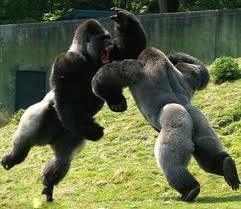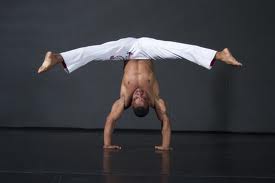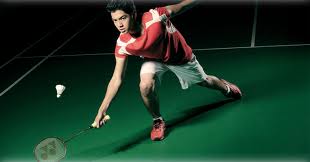Management Strategies
During tuesdays class we continued our gymnastics unit. Our host teacher set up several stations. He added the rope climb and the rock climb to the activities incorporated in the lesson. He split the class up into groups and let me know that things will probably bit crowded over by the balance beam (where I was working at). He was right. Within the first minute of rotations the balance beam line became extremely crowded. The next plan was to add another station so that it could keep the kids more occupied. He brought out a couple 4 wheeled scooters for the kids to maneuver up and across mid court. This would help delay the line getting longer but would not prevail. After everybody got a few rounds of getting on the beam I was told to skip students that already proved that they were more than capable of performing the task at a proficient level. By doing this it would eliminate the delay for the beam line but right after it was the wall climbing line which took just as long. I would have to move the kids along past the rock climbing wall too. This management of activities need to be organized differently so that everybody gets an equal opportunity to do the tasks without feeling rushed or uncomfortable.
Thursday, March 29, 2012
Sunday, March 25, 2012
Field Experience - 3/23/2012
Communication with colleagues, others
Friday consisted of another beautiful day out on the playground. I was previously told by my host teacher that we would be inside regardless of the weather. He informed me on my arrival that we would be going outside because of future weather conditions being poor. I was also not informed that we would be combining two of the Pre-K classes. So there was around 30 kids running around on the play ground. A few other people in the class working also showed up. There was four of us essentially being attacked by most of the class. The kids continue to be entertained and active just by playing tag. Tag turns into more of chase the teacher. The whole time we kept the kids moving and active. We did not communicate well at organizing a game or activity. We let the kids have their freedom and let them become active on their own. During the tag games the teachers were the ones being chased. When we were caught we were put in the “lava.” At this time we all understood that we were to play along and continue to stimulate their imagination. By the end of class the host teacher and ourselves talked about upcoming assignments we need to do for curriculum project. Hopefully a step in the right direction.
Tuesday, March 20, 2012
Field Experience - 3/20/2012
Knowledge of Students
I spent another day with the kindergarten class. Since the weather was nice outside my host teacher decided to take the kids out to the playground. The playground was still wet from the night before when it rained but that wouldn't stop the kids from being active. I have come to notice that simple games like tag are a go to game for younger kids. Many of the kids can play this for a full 30 minutes. I have noticed that a select few of the students get agitated when they are constantly being targeted. This tension built up and lead to a small altercation that was settled shortly after. This class consists mostly of boys with only a few girls. Some of the girls participate in tag for a majority of the class but aren't chased as much or can't always tag somebody. Today they spent the last ten minutes or so pretending to be ice cream saleswomen. They would hand out imaginary ice cream to those that came buy their shop. In return you would have to give them imaginary money. Tendencies have shown that boys will run themselves to exhaustion while many of the girls will be conservative and play along until they become mentally tired of the activity.
I spent another day with the kindergarten class. Since the weather was nice outside my host teacher decided to take the kids out to the playground. The playground was still wet from the night before when it rained but that wouldn't stop the kids from being active. I have come to notice that simple games like tag are a go to game for younger kids. Many of the kids can play this for a full 30 minutes. I have noticed that a select few of the students get agitated when they are constantly being targeted. This tension built up and lead to a small altercation that was settled shortly after. This class consists mostly of boys with only a few girls. Some of the girls participate in tag for a majority of the class but aren't chased as much or can't always tag somebody. Today they spent the last ten minutes or so pretending to be ice cream saleswomen. They would hand out imaginary ice cream to those that came buy their shop. In return you would have to give them imaginary money. Tendencies have shown that boys will run themselves to exhaustion while many of the girls will be conservative and play along until they become mentally tired of the activity.
Tuesday, March 13, 2012
Field Experience - 3/12/2012
Skill Themes and Student Abilities
Today in class the kindergarten started a gymnastics lesson. They started off and ended the class by playing Temple Tag. The three teachers split up the class into three different activities. There was log/pencil rolls, summersaults, and balance beam. I took the balance beam. There were about 6 or 7 kids to each group. There was one foam bar that laid on the ground with no distance to fall. The other bar was raised about a foot and a half off the ground. This was more realistic to regulation balance beams. I would have one student walk the main one as I spotted them from a close distance. If the student didn’t feel comfortable I would give them a hand or two for them to use as support. The rest of the kids practiced on the lower bar as they waited for their next turn. A majority of the class was very skilled and were able to cross the beam without any help or hesitation. I challenged these kids by telling them to stop in the center of the beam and stand on one foot for “two Mississippi seconds.” This made it a little more difficult but just about all of the people that attempted it except one were able to do it. The entire class showed good coordination and balance. There was only one student that struggled and required guidance the whole way through. She was very timid and clearly not comfortable attempting it by herself.
Sunday, March 11, 2012
Field Experience - 3/3/2012
Curriculum and NYS standards
Friday was another average day for the class. The kids were given tons of equipment and activities to choose from. They used their imagination to make up and play games. Since we do not get to see what the class does on the other days I am not sure of what their curriculum consists of. This class is a Pre K group that doesn't need to worry about the third standard. Students work on gross and fine motor movements during the different activities that are done. They learn through observation of teachers and through listening to cues given by teachers. So when I'm interacting with the students I can demonstrate and give them a word of advice as they practice that skill.
Friday was another average day for the class. The kids were given tons of equipment and activities to choose from. They used their imagination to make up and play games. Since we do not get to see what the class does on the other days I am not sure of what their curriculum consists of. This class is a Pre K group that doesn't need to worry about the third standard. Students work on gross and fine motor movements during the different activities that are done. They learn through observation of teachers and through listening to cues given by teachers. So when I'm interacting with the students I can demonstrate and give them a word of advice as they practice that skill.
Friday, March 2, 2012
Lab 16- Feb 29th 2012
1. Cardiovascular fitness
2. Flexibility
3. Strength
4. Muscular Endurance
5. Explosive Power
6. Agility
7. Reaction Time
8. Balance
9. Coordination
10. Speed
2. Flexibility
3. Strength
4. Muscular Endurance
5. Explosive Power
6. Agility
7. Reaction Time
8. Balance
9. Coordination
10. Speed
Subscribe to:
Comments (Atom)














